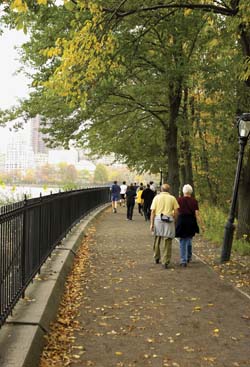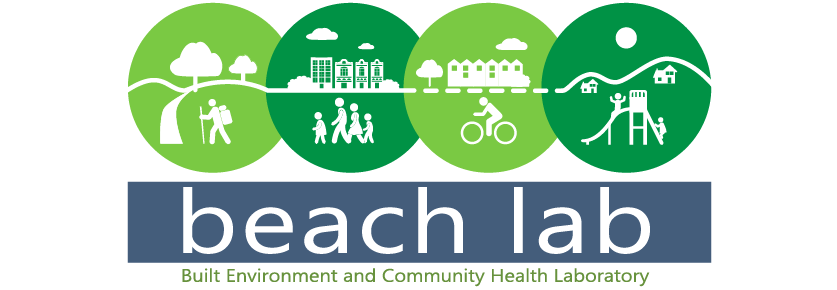| Association of Neighborhood Physical and Social Environments with Residents’ Physical Activity Behaviors and Overall Health |
|
The purpose of the Greenville Healthy Neighborhoods Project (GHNP) was to explore the relationship between neighborhood physical and social environment attributes and how both are related to residents’ physical activity patterns and overall health.
 Eight lower income neighborhoods in Greenville County, SC that were diverse with respect to available community resources and other walkability attributes participated in the Greenville Healthy Neighborhoods Project. Starting in February, 2014 focus groups were conducted in each neighborhood with approximately 8-11 residents. Findings from these focus groups were used to develop a household survey that was completed by a total of 430 adults who provided detailed information about perceptions of the physical and social attributes of the neighborhoods as well as their self-reported physical activity and overall health and well-being.
In 2015, the Greenville Healthy Neighborhoods Project research team will begin to analyze these data in order to inform both policy and residents alike about the role of neighborhood environments on health.
Preliminary findings from the project are described in this report.Additional findings from the data collected during this study are described in the following articles: Eight lower income neighborhoods in Greenville County, SC that were diverse with respect to available community resources and other walkability attributes participated in the Greenville Healthy Neighborhoods Project. Starting in February, 2014 focus groups were conducted in each neighborhood with approximately 8-11 residents. Findings from these focus groups were used to develop a household survey that was completed by a total of 430 adults who provided detailed information about perceptions of the physical and social attributes of the neighborhoods as well as their self-reported physical activity and overall health and well-being.
In 2015, the Greenville Healthy Neighborhoods Project research team will begin to analyze these data in order to inform both policy and residents alike about the role of neighborhood environments on health.
Preliminary findings from the project are described in this report.Additional findings from the data collected during this study are described in the following articles:
Child, S.T., Kaczynski, A.T., Fair, M.L., Stowe, E.W., Hughey, S.M., Boeckerman, L., Wills, S., & Reeder, Y. (2018). “We need a safe, walkable way to connect our sisters and brothers”: A qualitative study of opportunities and challenges for neighborhood-based physical activity among residents of low-income African American communities. Ethnicity and Health. https://doi.org/10.1080/13557858.2017.1351923 Child, S.T., Kaczynski, A.T., Walsemann, K.M., Fleischer, N.L., McLain, A., & Moore, S. (2019). Socioeconomic differences in access to neighborhood and network social capital and associations with body mass index among Black Americans. American Journal of Health Promotion. https://doi.org/10.1177/0890117119883583 Child, S.T., Walsemann, K.M., Kaczynski, A.T., Fleischer, N., McLain, A., & Moore, D.S. (2018). Personal network characteristics and body mass index: The role of education among Black Americans. Journal of Public Health. https://doi.org/10.1093/pubmed/fdy020 Child, S.T., Kaczynski, A.T., & Moore, D.S. (2017). Meeting physical activity recommendations: The role of personal networks among residents of low-income and historically-disadvantaged communities. American Journal of Preventive Medicine, 53(3), 385-391. https://doi.org/10.1016/j.amepre.2017.04.007 Henderson, H., Child, S.T., Moore, S., Moore, J.B., & Kaczynski, A.T. (2016). The influence of neighborhood aesthetics, safety, and social cohesion on perceived stress in disadvantaged communities. American Journal of Community Psychology, 58, 80-88. https://doi.org/10.1002/ajcp.12081Child, S.T., Kaczynski, A.T., & Moore, D.S. (2017). Meeting physical activity recommendations: The role of personal networks among residents of low-income and historically-disadvantaged communities. American Journal of Preventive Medicine, 53(3), 385-391.Henderson, H., Child, S.T., Moore, S., Moore, J.B., & Kaczynski, A.T. (2016). The influence of neighborhood aesthetics, safety, and social cohesion on perceived stress in disadvantaged communities. American Journal of Community Psychology, 58, 80-88. |
|
